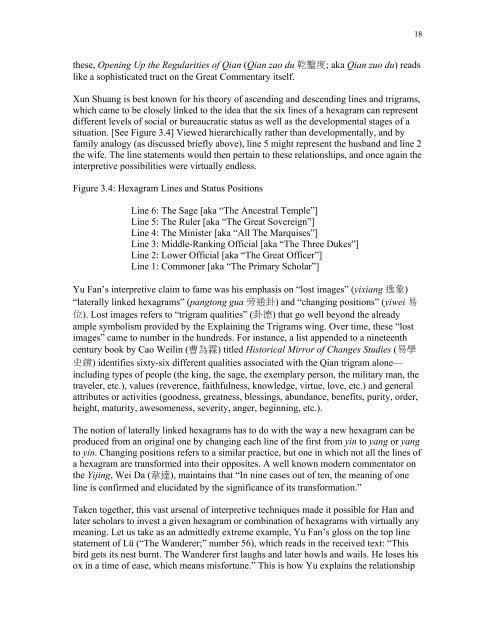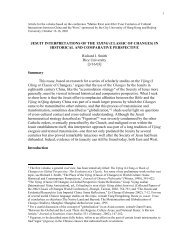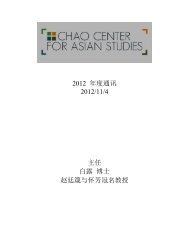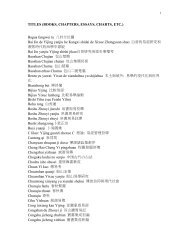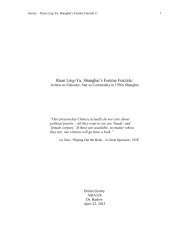18<strong>the</strong>se, Open<strong>in</strong>g Up <strong>the</strong> Regularities <strong>of</strong> Qian (Qian zao du ; aka Qian zuo du) readslike a sophisticated tract on <strong>the</strong> Great Commentary itself.Xun Shuang is best known <strong>for</strong> his <strong>the</strong>ory <strong>of</strong> ascend<strong>in</strong>g <strong>and</strong> descend<strong>in</strong>g l<strong>in</strong>es <strong>and</strong> trigrams,which came to be closely l<strong>in</strong>ked to <strong>the</strong> idea that <strong>the</strong> six l<strong>in</strong>es <strong>of</strong> a hexagram can representdifferent levels <strong>of</strong> social or bureaucratic status as well as <strong>the</strong> developmental stages <strong>of</strong> asituation. [See Figure 3.4] Viewed hierarchically ra<strong>the</strong>r than developmentally, <strong>and</strong> byfamily analogy (as discussed briefly above), l<strong>in</strong>e 5 might represent <strong>the</strong> husb<strong>and</strong> <strong>and</strong> l<strong>in</strong>e 2<strong>the</strong> wife. The l<strong>in</strong>e statements would <strong>the</strong>n perta<strong>in</strong> to <strong>the</strong>se relationships, <strong>and</strong> once aga<strong>in</strong> <strong>the</strong><strong>in</strong>terpretive possibilities were virtually endless.Figure 3.4: Hexagram L<strong>in</strong>es <strong>and</strong> Status PositionsL<strong>in</strong>e 6: The Sage [aka “The Ancestral Temple”]L<strong>in</strong>e 5: The Ruler [aka “The Great Sovereign”]L<strong>in</strong>e 4: The M<strong>in</strong>ister [aka “All The Marquises”]L<strong>in</strong>e 3: Middle-Rank<strong>in</strong>g Official [aka “The Three Dukes”]L<strong>in</strong>e 2: Lower Official [aka “The Great Officer”]L<strong>in</strong>e 1: Commoner [aka “The Primary Scholar”]Yu Fan’s <strong>in</strong>terpretive claim to fame was his emphasis on “lost images” (yixiang )“laterally l<strong>in</strong>ked hexagrams” (pangtong gua ) <strong>and</strong> “chang<strong>in</strong>g positions” (yiwei ). Lost images refers to “trigram qualities” () that go well beyond <strong>the</strong> alreadyample symbolism provided by <strong>the</strong> Expla<strong>in</strong><strong>in</strong>g <strong>the</strong> Trigrams w<strong>in</strong>g. Over time, <strong>the</strong>se “lostimages” came to number <strong>in</strong> <strong>the</strong> hundreds. For <strong>in</strong>stance, a list appended to a n<strong>in</strong>eteenthcentury book by Cao Weil<strong>in</strong> () titled Historical Mirror <strong>of</strong> Changes Studies () identifies sixty-six different qualities associated with <strong>the</strong> Qian trigram alone—<strong>in</strong>clud<strong>in</strong>g types <strong>of</strong> people (<strong>the</strong> k<strong>in</strong>g, <strong>the</strong> sage, <strong>the</strong> exemplary person, <strong>the</strong> military man, <strong>the</strong>traveler, etc.), values (reverence, faithfulness, knowledge, virtue, love, etc.) <strong>and</strong> generalattributes or activities (goodness, greatness, bless<strong>in</strong>gs, abundance, benefits, purity, order,height, maturity, awesomeness, severity, anger, beg<strong>in</strong>n<strong>in</strong>g, etc.).The notion <strong>of</strong> laterally l<strong>in</strong>ked hexagrams has to do with <strong>the</strong> way a new hexagram can beproduced from an orig<strong>in</strong>al one by chang<strong>in</strong>g each l<strong>in</strong>e <strong>of</strong> <strong>the</strong> first from y<strong>in</strong> to yang or yangto y<strong>in</strong>. Chang<strong>in</strong>g positions refers to a similar practice, but one <strong>in</strong> which not all <strong>the</strong> l<strong>in</strong>es <strong>of</strong>a hexagram are trans<strong>for</strong>med <strong>in</strong>to <strong>the</strong>ir opposites. A well known modern commentator on<strong>the</strong> Yij<strong>in</strong>g, Wei Da (), ma<strong>in</strong>ta<strong>in</strong>s that “In n<strong>in</strong>e cases out <strong>of</strong> ten, <strong>the</strong> mean<strong>in</strong>g <strong>of</strong> onel<strong>in</strong>e is confirmed <strong>and</strong> elucidated by <strong>the</strong> significance <strong>of</strong> its trans<strong>for</strong>mation.”Taken toge<strong>the</strong>r, this vast arsenal <strong>of</strong> <strong>in</strong>terpretive techniques made it possible <strong>for</strong> Han <strong>and</strong>later scholars to <strong>in</strong>vest a given hexagram or comb<strong>in</strong>ation <strong>of</strong> hexagrams with virtually anymean<strong>in</strong>g. Let us take as an admittedly extreme example, Yu Fan’s gloss on <strong>the</strong> top l<strong>in</strong>estatement <strong>of</strong> Lü (“The W<strong>and</strong>erer;” number 56), which reads <strong>in</strong> <strong>the</strong> received text: “Thisbird gets its nest burnt. The W<strong>and</strong>erer first laughs <strong>and</strong> later howls <strong>and</strong> wails. He loses hisox <strong>in</strong> a time <strong>of</strong> ease, which means mis<strong>for</strong>tune.” This is how Yu expla<strong>in</strong>s <strong>the</strong> relationship
19between this l<strong>in</strong>e statement, <strong>the</strong> structure <strong>of</strong> <strong>the</strong> hexagram, <strong>and</strong> <strong>the</strong> l<strong>in</strong>e statement <strong>of</strong> aderivative hexagram:The trigram, Li, is a bird <strong>and</strong> is fire; <strong>the</strong> trigram, Sun, is wood <strong>and</strong> is high. Thefourth l<strong>in</strong>e loses its position, chang<strong>in</strong>g <strong>in</strong>to <strong>the</strong> trigram Zhen, which is a basket,<strong>the</strong> image <strong>of</strong> a nest. Now, <strong>the</strong> image <strong>of</strong> a nest is not apparent; <strong>the</strong>re<strong>for</strong>e <strong>the</strong> birdburns its nest. The trigram Zhen refers to laugh<strong>in</strong>g, <strong>and</strong> . . . [it also signifies <strong>the</strong>idea <strong>of</strong>] a beg<strong>in</strong>n<strong>in</strong>g, <strong>and</strong> thus we have laugh<strong>in</strong>g at <strong>the</strong> outset. The response is <strong>in</strong><strong>the</strong> trigram Sun. Sun signifies howl<strong>in</strong>g <strong>and</strong> wail<strong>in</strong>g, <strong>and</strong> <strong>the</strong> image <strong>of</strong> Sun[signifies <strong>the</strong> idea <strong>of</strong>] afterward; thus, howl<strong>in</strong>g <strong>and</strong> wail<strong>in</strong>g take place later. When<strong>the</strong> third l<strong>in</strong>e moves [changes to a y<strong>in</strong> l<strong>in</strong>e], <strong>the</strong> trigram Kun is an ox, <strong>and</strong> when<strong>the</strong> fifth l<strong>in</strong>e moves [changes to a yang l<strong>in</strong>e], it <strong>for</strong>ms <strong>the</strong> trigram Qian, <strong>and</strong> Qianis ease. The top l<strong>in</strong>e loses <strong>the</strong> third l<strong>in</strong>e. The fifth l<strong>in</strong>e moves <strong>in</strong> response to <strong>the</strong>second l<strong>in</strong>e, thus <strong>the</strong> ox is lost <strong>in</strong> time <strong>of</strong> ease. Los<strong>in</strong>g its position <strong>and</strong> be<strong>in</strong>gwithout a response, it is <strong>the</strong>re<strong>for</strong>e <strong>in</strong>auspicious. If <strong>the</strong> fifth l<strong>in</strong>e changes, it <strong>for</strong>ms<strong>the</strong> hexagram Dun (Withdrawal, number 33), <strong>the</strong> second l<strong>in</strong>e [<strong>of</strong> which refers to<strong>the</strong> idea <strong>of</strong>] “hold<strong>in</strong>g with yellow ox hide”—<strong>the</strong> lost ox <strong>of</strong> <strong>the</strong> traveler’s family.Although this complex trigram symbolism can be traced to various previouscommentaries, <strong>the</strong> precise reasons that <strong>the</strong> l<strong>in</strong>es change <strong>and</strong> “lose <strong>the</strong>ir position” <strong>in</strong> thisparticular <strong>in</strong>stance are never made clear. Small wonder, <strong>the</strong>n, that a great many Ch<strong>in</strong>esescholars, both past <strong>and</strong> present, have criticized <strong>the</strong> “excesses” <strong>of</strong> this radically complexapproach to Images <strong>and</strong> Numbers <strong>in</strong> <strong>the</strong> Changes.One <strong>of</strong> <strong>the</strong> most vociferous early critics <strong>of</strong> Images <strong>and</strong> Numbers scholarship was WangBi (; 226-249), <strong>the</strong> progenitor <strong>of</strong> what became known as Abstruse Learn<strong>in</strong>g(Xuanxue ), a creative amalgamation <strong>of</strong> both Confucian <strong>and</strong> Daoist thought. Wangrejected <strong>the</strong> exegesis <strong>of</strong> Han th<strong>in</strong>kers like Zheng Xuan, Xun Shuang <strong>and</strong> Yu Fan almostentirely <strong>in</strong> favor <strong>of</strong> a Mean<strong>in</strong>gs <strong>and</strong> Pr<strong>in</strong>ciples approach to <strong>the</strong> Yij<strong>in</strong>g that stripped awayvirtually all <strong>of</strong> <strong>the</strong> complex <strong>and</strong> <strong>of</strong>ten confus<strong>in</strong>g numerical, astrological <strong>and</strong> calendricalcalculations that had been attached to <strong>the</strong> work by J<strong>in</strong>g Fang <strong>and</strong> his successors.The term “image” meant someth<strong>in</strong>g very different to Wang Bi than it did to his late Hanpredecessors. Ra<strong>the</strong>r than view<strong>in</strong>g a hexagram, trigram or l<strong>in</strong>e image as someth<strong>in</strong>g thatcould be quantified or calibrated with seem<strong>in</strong>gly <strong>in</strong>f<strong>in</strong>ite specificity <strong>and</strong> complexity,Wang considered hexagrams <strong>and</strong> trigrams to be a more general means <strong>of</strong> underst<strong>and</strong><strong>in</strong>gprocesses <strong>of</strong> change. Whereas Later Han commentators like Zheng, Xun <strong>and</strong> Yumeasured <strong>the</strong> mean<strong>in</strong>g <strong>and</strong> value <strong>of</strong> a hexagram <strong>in</strong> terms <strong>of</strong> its relationship to o<strong>the</strong>rhexagrams, all <strong>of</strong> which were enmeshed <strong>in</strong> an elaborate web <strong>of</strong> numerological <strong>and</strong> o<strong>the</strong>rsymbolic correspondences, Wang Bi focused on <strong>in</strong>dividual hexagrams, <strong>and</strong> <strong>the</strong> way <strong>the</strong>yillum<strong>in</strong>ated chang<strong>in</strong>g situations. As Wang put <strong>the</strong> matter <strong>in</strong> his famous essay, “GeneralRemarks on <strong>the</strong> Zhou Changes” (Zhouyi lueli ), “When we cite <strong>the</strong> name <strong>of</strong> ahexagram, <strong>in</strong> its mean<strong>in</strong>g we f<strong>in</strong>d <strong>the</strong> controll<strong>in</strong>g pr<strong>in</strong>ciple, <strong>and</strong> when we read <strong>the</strong> words<strong>of</strong> <strong>the</strong> judgment, <strong>the</strong>n we have got more than half <strong>the</strong> ideas <strong>in</strong>volved. . . . The hexagramsdeal with moments <strong>of</strong> time <strong>and</strong> <strong>the</strong> l<strong>in</strong>es are concerned with <strong>the</strong> states <strong>of</strong> change that areappropriate to those times.”


